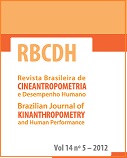Effect of different weekly amount of general physical training on flexibility in middle-aged women
DOI:
https://doi.org/10.1590/1980-0037.2012v14n5p582Abstract
The objective of this study was to evaluate the influence of a 15-month program based on aerobic, stretching, and localized exercises at different weekly amounts on the flexibility of middle-aged women. The study included 107 women randomly divided into three groups: Group 1 (n = 36, G1: 50.8 ± 12.5 years) trained three times a week; Group 2 (n = 36, G2: 51.0 ± 14.0 years) trained twice a week; and the control group (CG: n = 35, 52.1 ± 13.4 years) did not practice any exercise. During 15 months, G1 and G2 underwent a training program including aerobic, stretching, and localized exercises for 60 minutes. Participants were assessed every three months to check their progression. We found that both G1 and G2 showed improvement in flexibility (sit and reach test). However, from assessment “1” to post-test, G1 showed better results (20.16 ± 8.06; 23.61 ± 7.75; 25.22 ± 7.19; 26.76 ± 7.37; 27.71 ± 7.24; 29.47 ± 7.13) compared with G2 (17.69 ± 10.06; 18.58 ± 9.19; 19.44 ± 8.94; 20.67 ± 8.20; 21.17 ± 8.26; 23.17 ± 8.35). We concluded that practicing combined physical exercises two or three times a week tend to improve the levels of flexibility and that more satisfactory values are achieved when the amount of training is larger.



